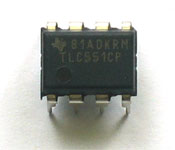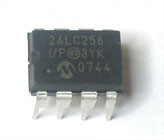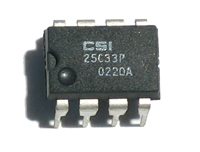Table of Contents
WANT MORE?? Dont forget to see everything else in the Part selector index!
Introduction
General notes:
- The C or I after the name is Commercial or Industrial temp.
- The P or N after the name indicates DIP package
Where else to find chips
Hopefully we (and other nice people) will be able to keep the distributor links current. But if we cant you can always search at http://www.findchips.com or http://www.octopart.com for other distributors such as Arrow, Avnet, Future, Jameco, etc. If you have a non-US distributor you use please add the links below so people outside the US can buy from their local shops.
Power Supply
Please see vreg for regulators & other power converters
Op amps!
Op amps are like the flavor crystals of electronics!
Some notes on op-amps:
- Op amps, of course, vary -widely- but here are some common ones
- The single '741' layout opamps have the same pinout in an 8-DIP package
- The double 'TL082' layout opamps have the same pinout in an 8-DIP package
- The quad 'TL084' layout opamps have the same pinout in a 14-DIP package
| Image | Part # & Datasheet | Description | Package notes | Op-amp notes | Distributor | Eagle lib. |
|---|---|---|---|---|---|---|
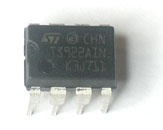 | TS922IN or TS922AIN | Rail-to-rail low voltage dual opamp | Dual '082' style | 2.7-12V supply Rail-to-rail in & out 50+mA output current | Digikey Mouser | linear:tl082 |
| " | LM741CN | Ye Olde Op amp. This is the 'classic' first internally compensated op-amp. They arent very good but were so popular in older designs, you'll run across them | Single '741' style | 10V-46V supply not rail-to-rail | Digikey Mouser | linear:*741 |
| " | Tl082CN | A nice general purpose dual opamp w/JFET inputs | Dual '082' style | 6-36V supply Not rail-to-rail | Digikey Mouser | linear:tl082 |
| " | Tl084CN | Quad opamp with JFET inputs (effectively two TL082's) | Quad '084' style | 6-36V supply Not rail-to-rail | Digikey Mouser | linear:tl084 |
| " | AD620 | An instrumentation amplifier that can be programmed for gains of 1-10,000 with a single resistor. | 8 pin DIP or SOIC | ±2.3 V to ±18 V, Low noise | Digikey | analog-devices:AD620 |
| PDIP-14/no image yet | LM324N | General purpose quad opamp - same pinout as TL084, but higher PSRR and lower minimum supply voltage. BJT inputs. | Quad '084' style | 3-32V supply Not rail-to-rail | Digikey Mouser | linear:lm324 |
Timers
Some notes on timer chips:
- The most common timer chip is the 555, but it comes in a few flavors!
- 555s are commidified, you'll see them made by dozens of manufacturers.
- Pretty much any '555 is pin compatible with different power ratings, voltage ratings, max frequency etc.
- NE555, SE555 LM555 is the 'original' TTL version but is power hungry, and needs 4.5V or higher to run! In general the CMOS versions are better
- The TLC551CP is ultra low voltage, can run on 1V, making it perfect for single-alkaline-battery operation
Logic
Some notes on 74' logic chips:
- They are for the most part 1.8-5.5v devices, and can be clocked as fast as 100MHz.
- HC is the most common CMOS logic. AHC has 5V compliant logic even when running with a VCC of 3.3v.
- The N at the end means DIP package, which is what you want for breadboarding.
- There are dozens of manufacturers that may add prefixes, and they're pretty much the same so grab whatever you can! Especially look for MM74HCxxx (fairchild) and SN74HCxxx (texas instruments)
| Image | Part # & Datasheet | Description | Distributor | Eagle library |
|---|---|---|---|---|
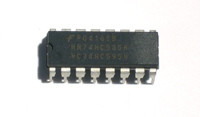 | 74HC595N | 8-bit serial-to-parallel latch Can be cascaded for controlling dozens of digital outputs | Mouser Digikey | |
 | TPIC6C596N | Just like the 74'595 but is the current sinking version of the 74HC595 Specifically for driving lots of LEDs | Mouser Digikey | |
 | 74HC165N | 8-bit parallel-to-serial latch Can be cascaded for reading dozens of digital inputs | Digikey Mouser | |
 | 74AHC125N | Tri-stateable buffer, 5V compliant We use these for logic level shifting 5v → 3v | Mouser | 74xx:74*125 |
 | CD4050 | 6-channel level shifter, 5V compliant We use these for logic level shifting 5v → 3v | Mouser Digikey | 40xx:4050N |
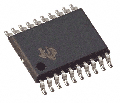 | TXB0108 | Bi-directional level shifter w/auto-detection | Digikey Mouser | adafruit:TXB0108PWR |
EEPROM
Notes on EEPROMS:
- EEPROMs are commodified so the part numbers may vary a little
- EEPROMs are generally I2C (2 wire) - starts with 24, or SPI (3 wire) - starts with 25. SPI is a bit faster but more $.
- I2C and SPI are completely incompatible and if you need one or the other for an existing design you cannot swap them
- They have a voltage range that can be 5V only or 1.8-5V. This list specifies 1.8V+ EEPROMs since those will work in the most situations
- The numbers in the end indicate kilobits (not KB!): '08 is 1 KB, '160 is 2 KB, '320 is 4 KB, '640 is 8 KB, '128 is 16 KB, '256 is 32KB, '512 is 64KB, etc.
Motor control
- Notes on using the SN754410 v L293D: Some people use the SN754410 motor driver chip because it is pin-compatible, has output diodes and can provide 1A per motor, 2A peak. After careful reading of the datasheet and discussion with TI tech support and power engineers it appears that the output diodes were designed for ESD protection only and that using them as kickback-protection is a hack and not guaranteed for performance. For that reason Adafruit kits do not come with the SN754410 and instead use the L293D with integrated kickback-protection diodes. If you're willing to risk it, and need the extra currrent, feel free to buy SN754410s and replace the provided chips!
- Only the L293D(N), includes kickback diodes so you'll need 'em! You can use Schottky diodes such as 1N5818 (preferred) or 1N4001s
| Image | Part # & Datasheet | Description | Distributor | Eaglie lib |
|---|---|---|---|---|
 | L293D or L293DN | 2 H-bridges w/built-in diodes 0.6A per channel 4V-36V 1 stepper / 2 DC motors / 4 solenoids | Mouser Digikey Digikey Jameco Allied Arrow Avnet | st-microelectronics:L293D |
 | SN754410N | 2 H-bridges w/ESD diodes 1 A per channel 4V-36V 1 stepper / 2 DC motors / 4 solenoids | Mouser Digikey | st-microelectronics:L293D |
| 'multiwatt' package | L298N | 2 H-bridges 2.5+ Amp per channel 4V-48V | Digikey Mouser | st-microelectronics:L298 |
RTC
Real time clocks!
| Image | Part # and datasheet | Description | Distributor | Eagle lib. |
|---|---|---|---|---|
 | DS1307 | Real time clock with battery backup | Mouser Digikey Maxim | Adafruit:DS1307 |
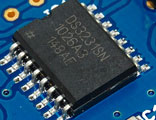 | Maxim DS3231 | High precision real time clock with built in oscillator | Digikey Mouser Newark Maxim Direct | |
| "" | NXP PCF2129 | Ditto, but only up to 4V | Digikey Mouser | microbuilder:pcf2129 |
I/O Expanders and MUXes
| Image | Part # and datasheet | Description | Distributor | Eagle lib. |
|---|---|---|---|---|
 | MCP23008 | 8-bit input/output with pull-ups and interrupt support | Digikey Mouser | Adafruit:MCP23008 |
 | 74HCT4067 | 16:1 analog multiplexer w/60 ohm resistance | Digikey Mouser | 40xx:4067 |
 | 74HC4051 | 8:1 analog multiplexer | Digikey Mouser | 40xx:4051 |
 | 74HC4052 | Dual 4:1 analog mulitplexer | Digikey Mouser | 40xx:4052 |
Mystical (Obsolete)
These chips dont really exist anymore, but when they did it was AWESOME
| Image | Part # and datasheet | Description | Distributor |
|---|---|---|---|
| 20-dip | ICL8038 and MAX038 | "The MAX038 is (was) a high-frequency, precision function generator producing accurate, high-frequency triangle, sawtooth, sine, square, and pulse waveforms with a minimum of external components. The output frequency can be controlled over a frequency range of 0.1Hz to 20MHz | No longer made |
| 28-dip | SN76477 | "The SN76477 'complex sound generator' was a sound chip produced by Texas Instruments (TI). The chip came to market in 1978, and TI production of the part ceased some time ago. More recently, a 100% compatible version, identified as ICS76477, has been listed as 'in stock' by at least one US-based component stockist. The chip was typically used as a sound effects generator in arcade games & toys and for hobby projects." | No longer made |

